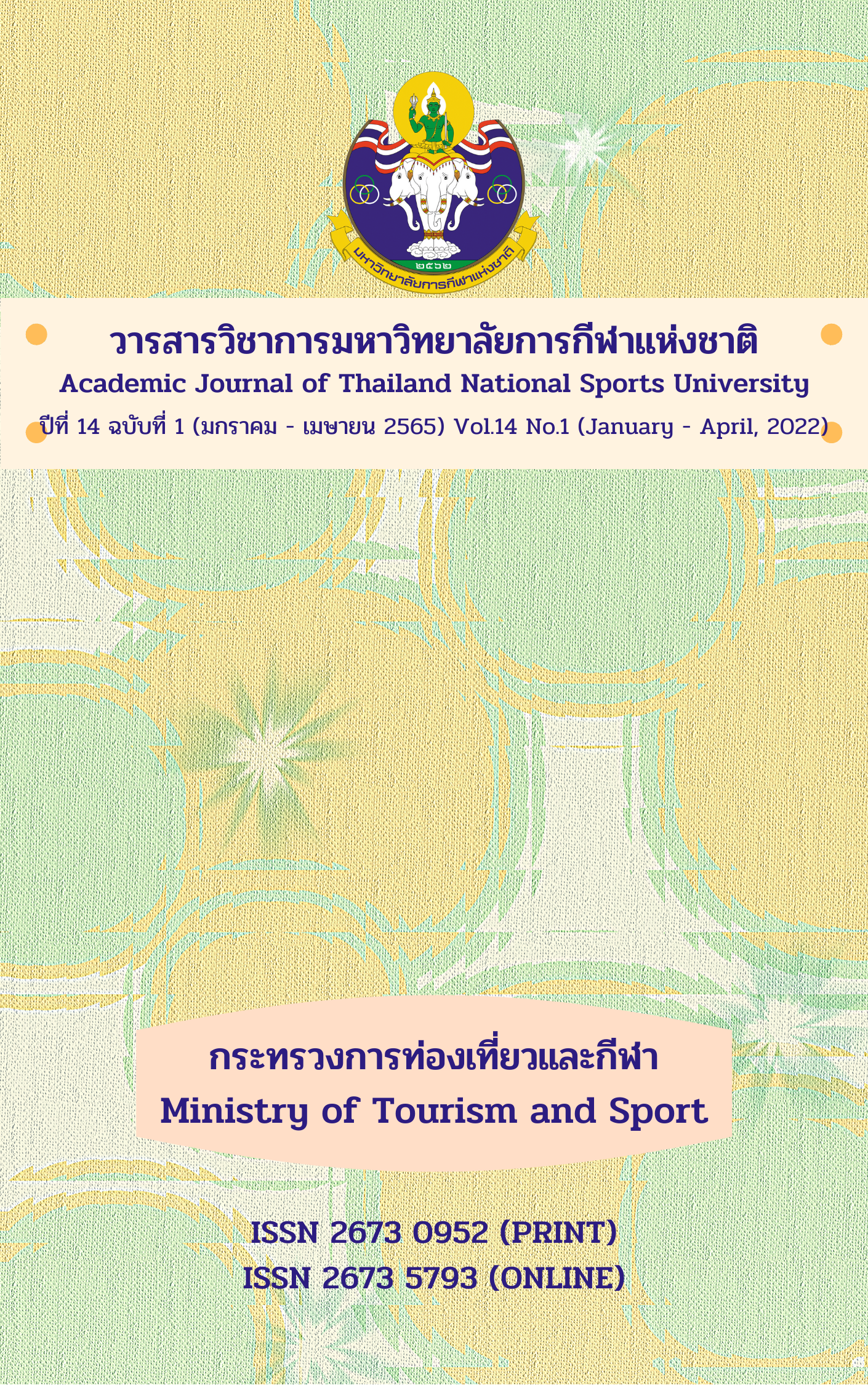THE EFFECTS OF AUTISSWIM PROGRAM ON SURVIVAL SWIMMING SKILLS AND PHYSICAL FITNESS FOR AUTISTIC CHILDREN
Main Article Content
Abstract
The purpose of this research was to evaluate the effectiveness of using autisswim program on survival swimming skills and physical fitness for autistic children after the Autisswim training program. The sample group in this study consisting of 6 parents and 6 autistic children aged 7 to 12 years was selected by using the purposive sampling, which had come to receive services at the National Institute for Child and Family Development, Mahidol University since January 2016 to December 2018. The samples were screened by 1) Early Childhood Development Test (Denver II) and 2) Swimming Basics Adjustment Evaluation Form. Data were collected by 1) The Autisswim Program, 2) Autisswim Program Teaching Data Recording Form, 3) Survival Swimming Skills Before and After Study Evaluation Form, 4) Personal Information Questionnaire of Autisswim program, 5) Physical Fitness Assessment Form, and 6) Parents interview form for Autisswim program. Data were analyzed by Descriptive Statistics, Qualitative Data Analysis, The McNemar Test and The Wilcoxon Matched Pair Signed - Ranks Test to examine the hypothesis.
Results showed that after the training through the Autisswim program, four samples were able to pass the survival swimming skills test, but two samples were not. The Autisswim Program resulted in the samples to have 3 aspects of survival swimming skills, namely 1) breath control skill 2) buoyancy skill and 3) life jacket wearing skill with statistical significance at the .05 level. In addition, a statistically significant at the .05 level increase was found in physical fitness, muscle strength, elasticity and balance among the samples after the Autisswim training program. The results also showed social skills of the samples has also improved. No significant differences were found in the movement skill and lifesaving skills of the samples.
Article Details

This work is licensed under a Creative Commons Attribution-NonCommercial-NoDerivatives 4.0 International License.
The published article is a copyright of the Academic Journal of Thailand National Sports University. The passage appeared in each article in this academic journal is a perspective of each author which is not related to the journal. Each author is required to be responsible for all components of his/her own article. If there are any mistakes, each author must be responsible for those mistakes on his/her own.
References
Arunya Buttichak. (2009). Effects of fit ball exercise on flexibility, balance and muscular strength of the autistic children (Master’s thesis), Chulalongkorn University.
Brennan, A. (2010). Teaching aquatic skills to children with autism spectrum disorders. Bachelor’s thesis. Illinois, USA: Southern Illinois University Carbondale. Retrieved from https://opensiuc.lib.siu.edu/cgi/viewcontent.cgi?article=1010&context =gs_rp
Bureau of Non Communicable Disease. (2009). Survival Swimming Curriculum and Handbook. Nonthaburi: War Veterans Organization of Thailand Publishing House.
Folkins, C. H., & Sime, W. E. (1981). Physical fitness training and mental health. American Psychologist, 36(4), 373 - 389. Retrieved from https://psycnet.apa.org/record/1982-01569-001
Hall, J. M. (2013). Aquatic strategies and techniques and their benefit on children with autism (Master’s thesis), University of Northern Iowa. Retrieved from https://scholarworks.uni.edu/cgi/viewcontent.cgi?article=1005&context=etd
Hataitip Numonggud. (2014). Direct instruction and video lessons for an increasing of autistic children's ability to perceive emotion of the other (Master’s thesis), Silpakorn University. Retrieved from http://www.sure.su.ac.th/xmlui/bitstream/handle/1234567 89/10651/fulltext.pdf?sequence=2&isAllowed=y
Kaewta Nopmaneejumruslers. (2008). Floor time and learn: Promoting special children's life skills by playing. Retrieved from http://www.cf.mahidol.ac.th/autopage/file/Mon August2008-10-40-16-Copy%20of%206.pdf
Kafkas1, A., & Ozen, G. (2015). Teaching of swimming technique to children with autism: A Pilot Study. Journal of Rehabilitation and Health on Disability, 1(1), 12 - 20.
Kittisak Luesuk. (2016). Effects of yoga activity management on flexibility, balance and concentration of the autistic students (Master’s thesis), Chulalongkorn University.
Lowes, S. K. (2015). Swim for fun: The importance of open swim for children with special needs (Master’s thesis), California State University of Monterey Bay. Retrieved from https://digitalcommons.csumb.edu/cgi/viewcontent.cgi?article=1492&context=caps_thes
Mailman School of Public Health. (2017). Individuals with Autism at Substantially Heightened Risk for Injury Death. Retrieved from https://www.publichealth.columbia.edu/public-health-now/news/individuals-autism-substantially-heightened-risk-injury-death
Nirut Sukdee. (2014). Effects of exercise using bosu ball on balance, muscular strength and cardiovascular system of the autistic children (Master’s thesis), Chulalongkorn University.
Nittaya Kotchabhakdi. (2015). Training Manual for Early Childhood Development Testing (6th ed.). Nakhon Pathom: National Institute for Child and Family Development Mahidol University.
Padung Arayawinyu. (2003). Single subject design. Bangkok: I.Q. Book center.
Pan, C. Y. (2010). Effects of water exercise swimming program on aquatic skills and social behaviors in children with autism spectrum disorders. Autism, 14(1), 9 - 28.
Ruht Laohapakdee. (2012). The effects of Mai Plong exercise program on motor ability and social skills of the child with autistic spectrum disorder (Doctoral dissertation), Chulalongkorn University.
Strategy and Planning Division. (2016). Death rate from drowning 2006 – 2015. Bangkok: Strategy and Planning Division.
Sulibhorn Cheewapanich. (2005). Effects of hydrotherapy: halliwick method on behaviours of the autistic individuals. Chiangmai: Chiangmai University.
Supit Samahito (2012). Tests and benchmarks for physical fitness tests for children aged 7 - 18 years. Nonthaburi: Samphachanya Publishing.
Taylor, B. C., Sallis, J. F., & Needle, R. (1985). The relation of physical activity and exercise to mental health. Public Health Reports, 100(2), 195 – 202.
Thanit Taechatugkiyaphan. (2007). The efficacy of video media an tooth brushing instruction in autistic children (Master’s thesis), Chulalongkorn University.
Vichuda Kongsut. (2002). Effects of plyometric training with a medicine ball and a rubber band on the upper body muscular power and swimming speed of swimmers (Master’s thesis), Chulalongkorn University.
World Health Organization. (2015). Global report on drowning: Preventing a leading killer. Retrieved from http://www.who.int/violence_injury_prevention/global_report _drowning/en/
Wuttichai Jainapa. (2013). Social skills practive of Autistic students trhough power cards accompanied with simalation situations (Master’s thesis), Silpakorn University. Retrieved from http://sure.su.ac.th/xmlui/bitstream/handle/123456789/10646/fulltext.pdf?sequence=2&isAllowed=y
Yilmaz, I., Yanarda, M., Birkan, B., & Bumin, G. (2004). Effects of swimming training on physical fitness and water orientation in autism. Pediatrics International, 46(5), 624 - 626.


